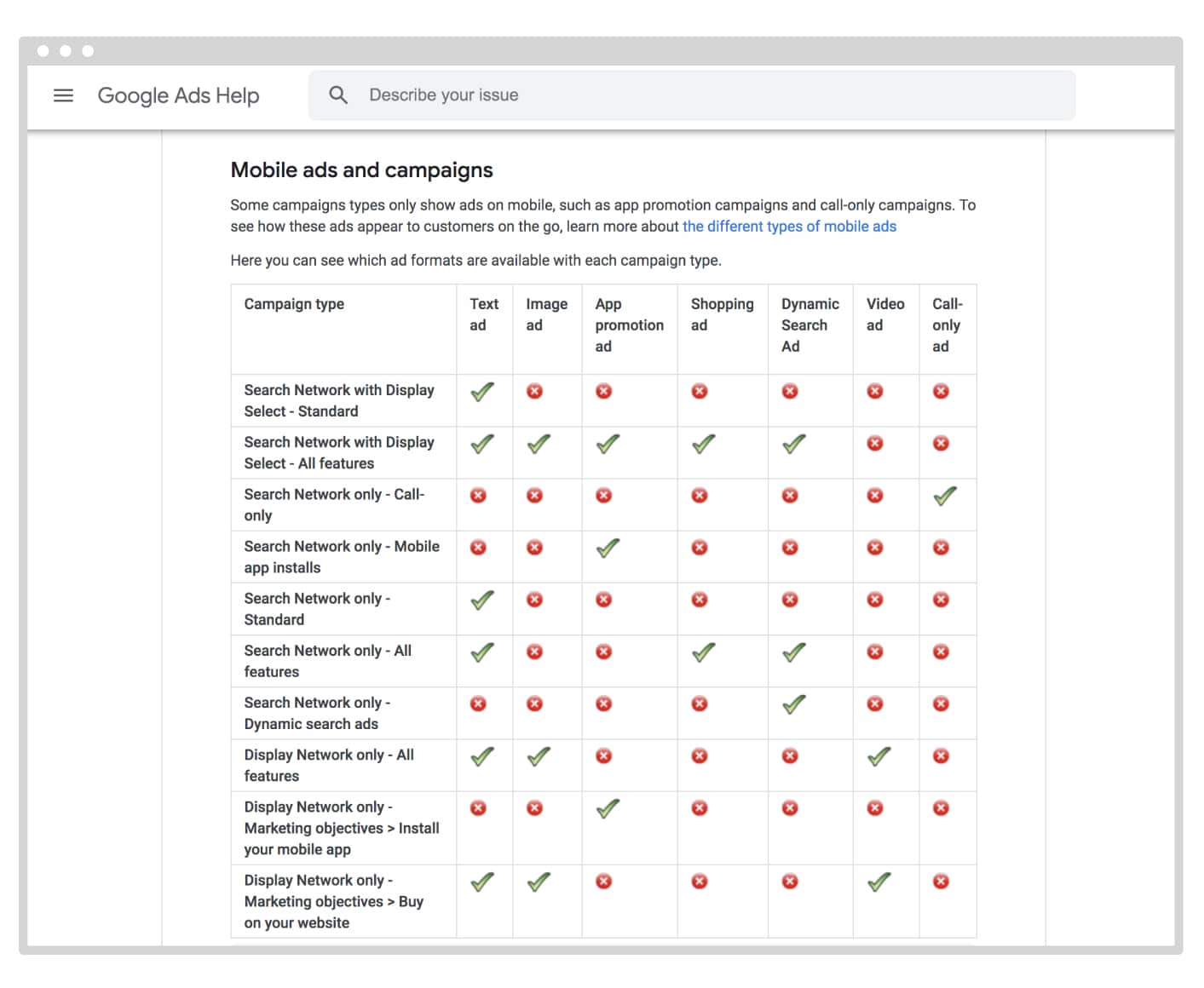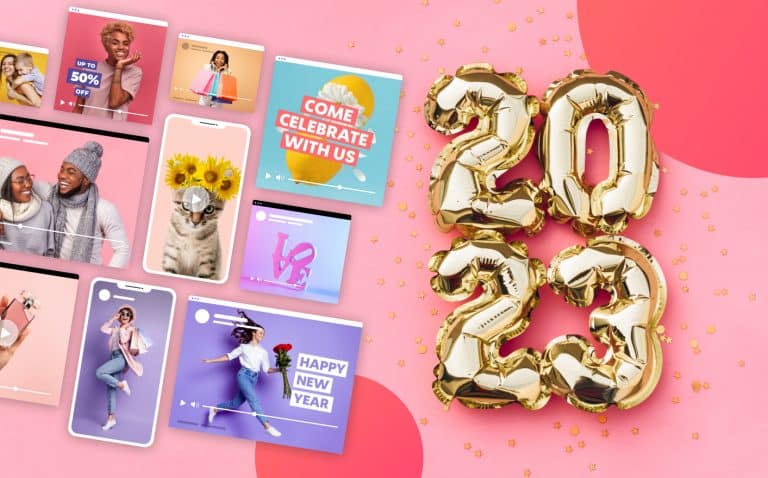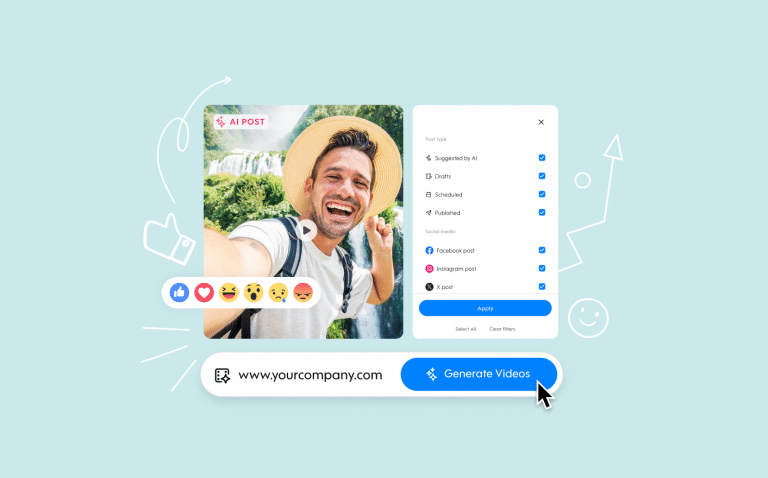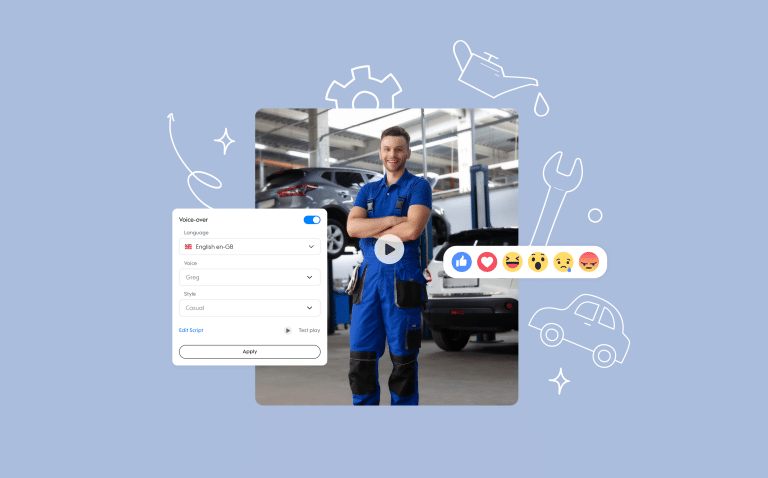
Video Ads vs Image Ads: A Comparison
You have an advertising budget. You know you want to target audiences on Facebook, Instagram, and Google.
But there are still some looming questions that make forging the path ahead uncertain. Should you focus on creating video ads or is it better to stick with image ads? Does one type of ad perform better than the other? Which one drives the most sales?
We’re about to cover all of this and more in this article.
Ready to create video ads that boost revenue and brand awareness? Give Promo.com a test drive today and create videos that your audience will love.
Video ads vs image ads: The verdict
Studies have proven time and time again that consumers prefer video content over static images. Here are a few examples:
- Facebook video ads receive 10 to 30 percent more views than other ad formats.
- When it comes to Instagram, organic video posts and video ads get 38% more engagement than images.
- Over 50 percent of consumers say that they want to see more video content from brands they like.
- Top publishers using Instagram, originally an image-based platform, are ramping up video posts by 90-100% each year.
In other words: Video ads have been shown to perform better than other media formats on Facebook and other advertising platforms, including image ads.
Best of all, it’s not just that consumers like video ads, they also drive performance. Lemonlight found that 93% of businesses reported gaining a new customer as a direct result of a video posted on social media.
But while video might perform better, that doesn’t mean image ads have no place in your strategy.
Image ads should absolutely have a place in your advertising plan, and others have tested this out to prove that. The team over at Hubspot were so curious about the performance contrast in video ads vs image ads that they tested it with Facebook Ads to find the answer for themselves.
Image ads vs video ads: What is Hubspot saying?
Here are the tests they conducted and the results they found.
1. Blog post feature image ad vs. video ad
In this A/B test, the goal was to send traffic to blog content.

They created a video ad with great music and good transitions alongside a simple image ad that showed only the blog post’s designated feature image.
Result: The video outperformed the image ad and drew 20 percent higher clicks.
2. Two Facebook video ads vs. optimized image ad
In this split test, they tested 3 ads at once instead of just two as listed before.
- A listicle video (shown above)
- A narration video
- An image ad
Instead of using the default blog post feature image, the team decided to use an optimized image that was actually a slide from the listicle video they were running.
Result: In doing so, things shifted and resulted in the image ad receiving more clicks at a lower cost than that listicle video.
With that being said, the third video — a video that included narration — tested alongside both of these still beat the image ad with the most clicks and at a 3% lower cost.
The overall takeaway of HubSpot’s advertising test
Even though the image-based Facebook ad didn’t outperform the narration video in the second test, it did perform better and at a lower cost than the other video ad they were running.
What we can take from this is that video content might outperform images, BUT Not all video content. Great video content will probably outperform a great image, but it’s not likely that a mediocre video will outperform a great image.
But what’s the bigger takeaway?
You need to test, optimize, and then test some more. By testing image-based ads against not just one, but two videos, they were able to narrow down the type of ad that reached their audience and their goals.
Image ads vs video ads: What is Facebook saying?
Being a heavyweight champion in the advertising world, Facebook also has a lot to say on which ads as a whole. But when asked which type of ad to create, their answer was “[it] depends on the goal.”
In their own experiments, Facebook found that instead of seeing image and video as competing options, great results actually come from combining them into a sequential campaign.
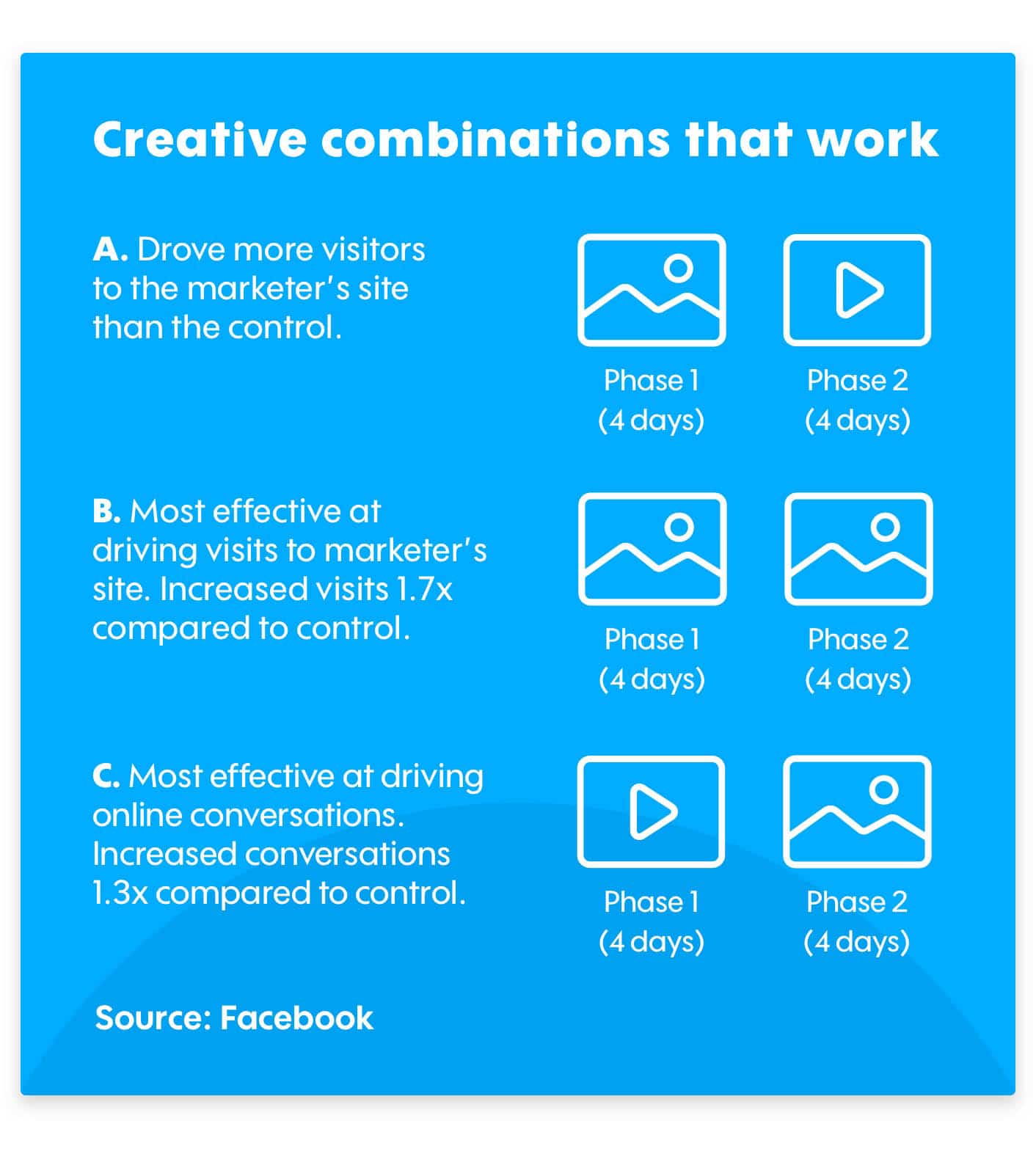 In Facebook’s case study, they found that showing an audience a video ad followed by a static image was able to generate the most conversions. In fact, this sequence was 31% more likely to generate an online transaction when compared with other combinations.
In Facebook’s case study, they found that showing an audience a video ad followed by a static image was able to generate the most conversions. In fact, this sequence was 31% more likely to generate an online transaction when compared with other combinations.
So, we definitely don’t recommend that you ignore static image ads completely. Test both or use them together. Then optimizing each one with multiple ad tests to find the style and format that’s resonating with your target audience.
Remember, one ad set might work better with one target audience in one part of your funnel, while another ad set may perform better when the target audience is different. You have to continually test to find what works for you.
Comparing Facebook, Instagram, and Google
In this post, we’re looking at these 3 specific options for video vs. image ads:
- Google Display Network
Each platform has different ad types, reach, costs, and even click-through-rate (CTR). First, let’s take a look at each one separately.
Facebook advertising: Average cost, ad types, reach and CTR
Facebook ads have long held the title as the best ad platform, and with good reason. Nearly 1.5 billion people are active on Facebook every day and the platform adds about 6 new profiles every second. In the past, we’ve delved deeply into the topic of Facebook advertising and how much Facebook ads cost. What we’ve learned is that the cost of running ads and their given ROI are going to vary a lot.
In general terms, the average cost-per-click (CPC) for Facebook ads is about $0.97 and average CTR for Facebook ads is about 1.44%. However, specifics on whether image ads or video ads are cheaper isn’t so easy to hunt down, but that’s to be expected.
Average costs vary by industry, your campaign objective, ad placement, and timing. Also, cost relies heavily on how much engagement your ad gets from your target audience.
It is SUPER important to continuously isolate and test all of these variables.
That said, many agree with the advice from Damon Gochneaur, founder of the digital marketing company, Aspiro Agency who says to use video on Facebook anywhere you can — especially when you are looking to lower costs.
In his experience, according to what he shared with WordStream, “video is, on average, 10% of the cost of carousel or single image ads.” He went on to say, “We pay on average anywhere from $0.15 to $0.50 per click on video campaigns, with single image ads at $2.00 and higher CPC, for the same audience.”
Katy Lowe, Social Media Executive at the digital marketing agency Passion Digital added to this in the same article, saying, “Facebook values video content in ads because it gives videos bigger impression share and therefore cheaper CPC.”
It’s safe to assume that, on average, video ads are cheaper than other Facebook formats (for now). But don’t expect that to last forever. Keep testing and iterating to see what works–and stay ahead of trends to see what consumers are responding to at the moment.
Facebook ad types, placements, and mobile vs. desktop
Facebook has quite a few ad types and placements. Below is a list of ad formats and placements that work with video and/or images:
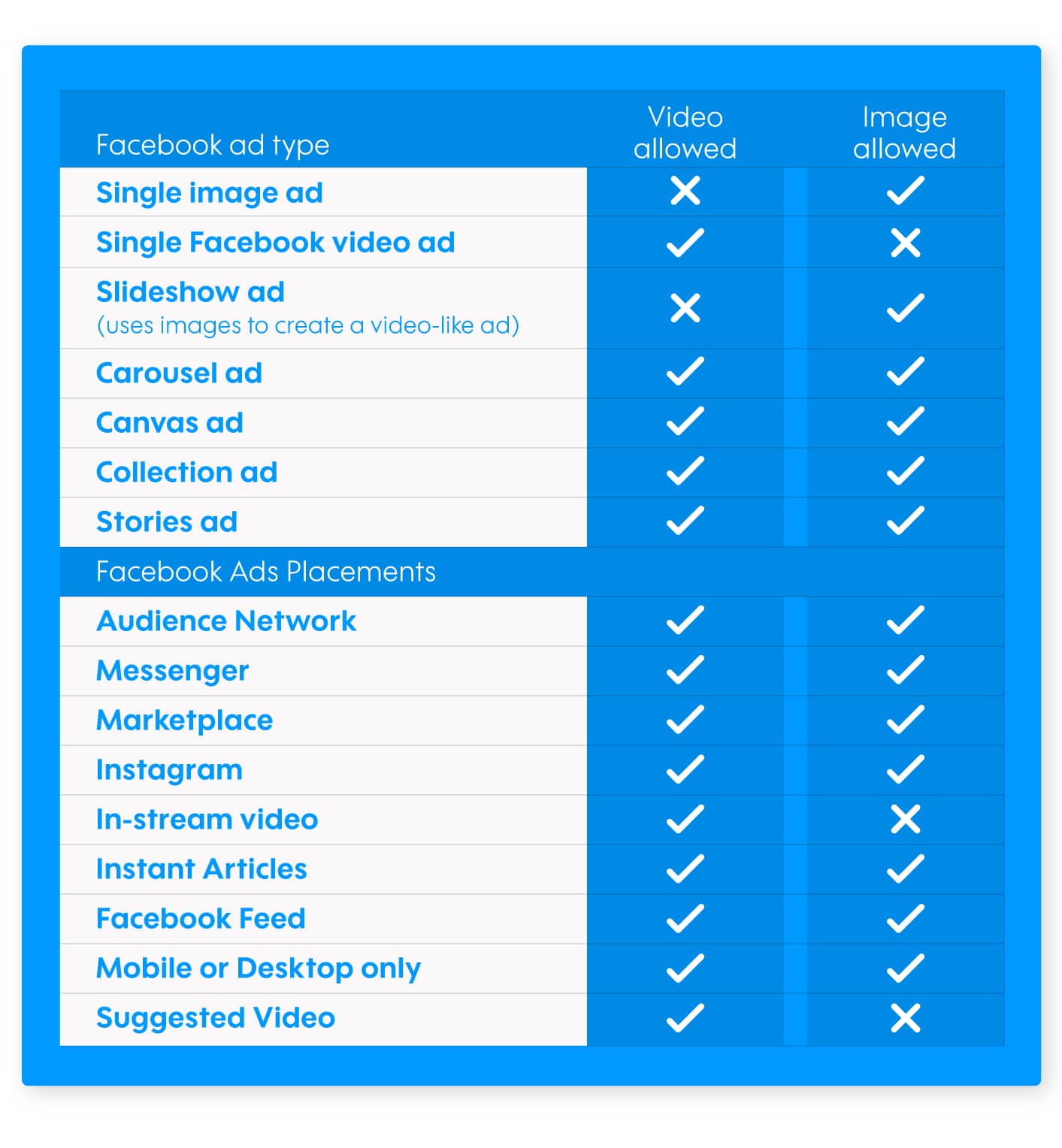 While ad types like “single image” or “single video” limit you to one designated creative type, others let you mix it up by using both images and videos in your ads. Where you place your ads can impact your ROI as well.
While ad types like “single image” or “single video” limit you to one designated creative type, others let you mix it up by using both images and videos in your ads. Where you place your ads can impact your ROI as well.
Facebook Audience Network is an off-Facebook advertising network for mobile apps. Advertisers can show up ads to customers who are using other sites and apps other than Facebook.
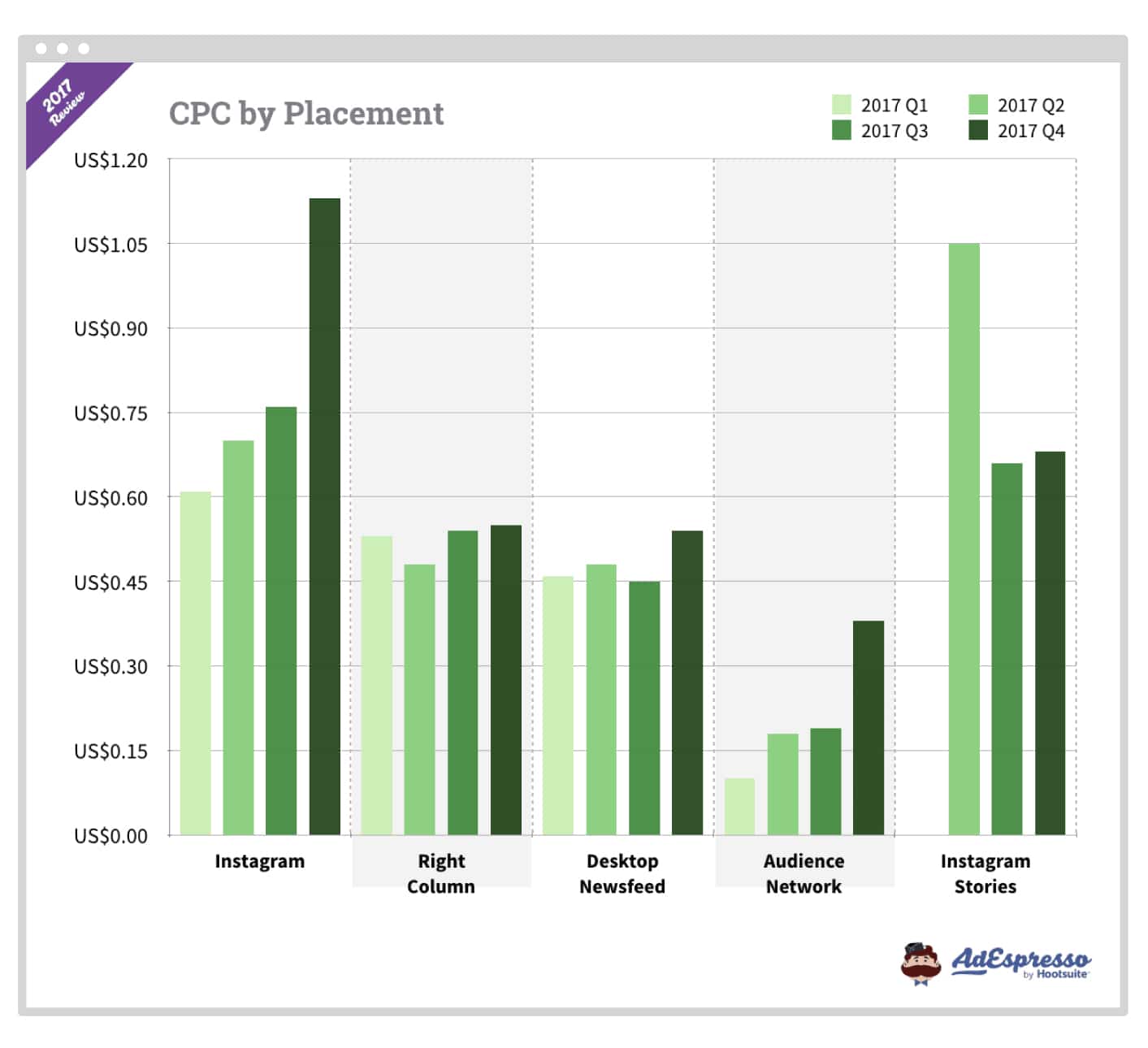 Source: AdEspresso
Source: AdEspresso
Including the Audience Network for your ads can be a smart move since viewability rates for in-stream video ads at 92%. To add to that, AdEspresso found that no matter what point of the year it is, ads on the Audience Network — both image and video ads — are the most cost-effective.
Instagram Advertising: Average cost, ad types, reach and CTR
Technically speaking, Facebook owns Instagram and you need to go through the Facebook Ads platform to set up your Instagram ads. However, Facebook is not Instagram and vice versa. They’re two very different social networks and each has different options as far as ad types, placement, and reach. For instance, the cost is a major difference.
Compared to ads on Facebook and the Audience Network, Instagram ads have been and likely always will be more expensive.
And how does the price of Instagram’s video ads compared to images?
Instagram video ads get about 3 times as much engagement (mostly comments) than sponsored photos. And even though the average click-through-rate is 0.52%, both organic video posts and video ads, receive 38% more engagement than photos.
When you’re targeting only Instagram, the choices for ad types, formats and placements shrinks a lot.
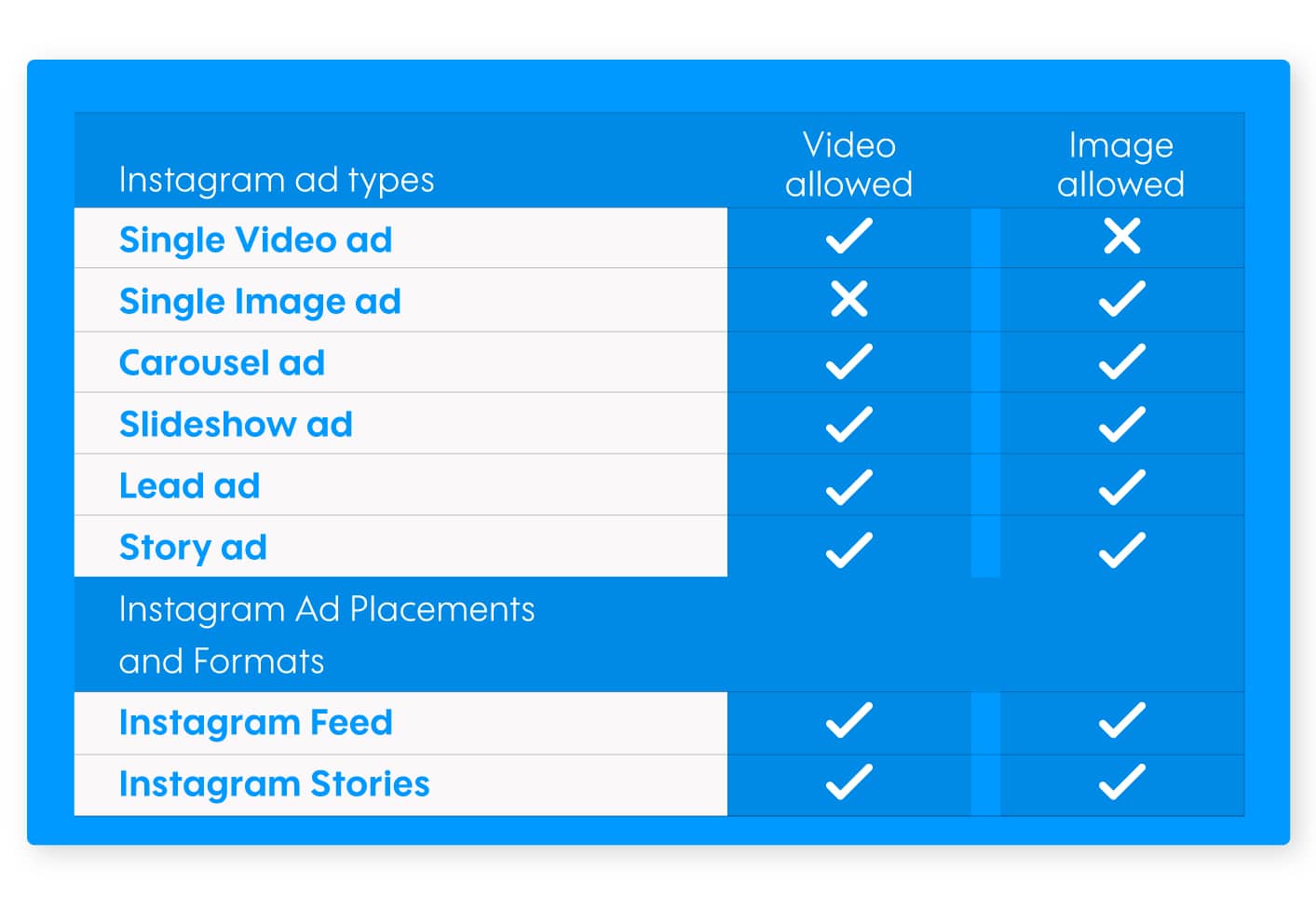 Instagram ads only appear on a mobile device, and you only have two choices of places to post: Instagram feed and Stories.
Instagram ads only appear on a mobile device, and you only have two choices of places to post: Instagram feed and Stories.
If you’re wondering which would be the best route for ads, AdEspresso suggests Instagram stories as they’re still lower in cost with very high engagement. You can A/B test Story video ads vs image ads to find which ones will work better for your objectives.
When you look at targeting ads (including video ads) in the U.S., the average CPC is $3.56.
However, Instagram has a very high level of engagement and ROI making this increase in cost a worthwhile platform to target. Shopify found that the Average Order Value from Instagram was $65 and conversion rate averages about 3.1%.
Google Display Network: Average cost and CTR, ad types, and reach
The Google Display Network (GDN) — which has nearly 2 million sites and reaches more than 90% of all internet users — is part of the Google Ads platform.
Ads put on Google’s Display Network has the potential to reach across a “large collection of websites, mobile apps, and video content” including YouTube, mobile sites, and sites that include monetization for the site’s owner using Google AdSense.
In-stream video ads — ads that play within a YouTube video — are one type of ad that you can create and use with the Display Network. One e-commerce company was able to generate $4.7 million in revenue using video ads including targeting in-stream video ads.
But don’t skip image ads.
Even though more than 67% of Display Network ads are plain text, image ads get a much better click-through-rate.
As far as when you should use the Display Network, many experts agree that using it for re-marketing is a great place to start.
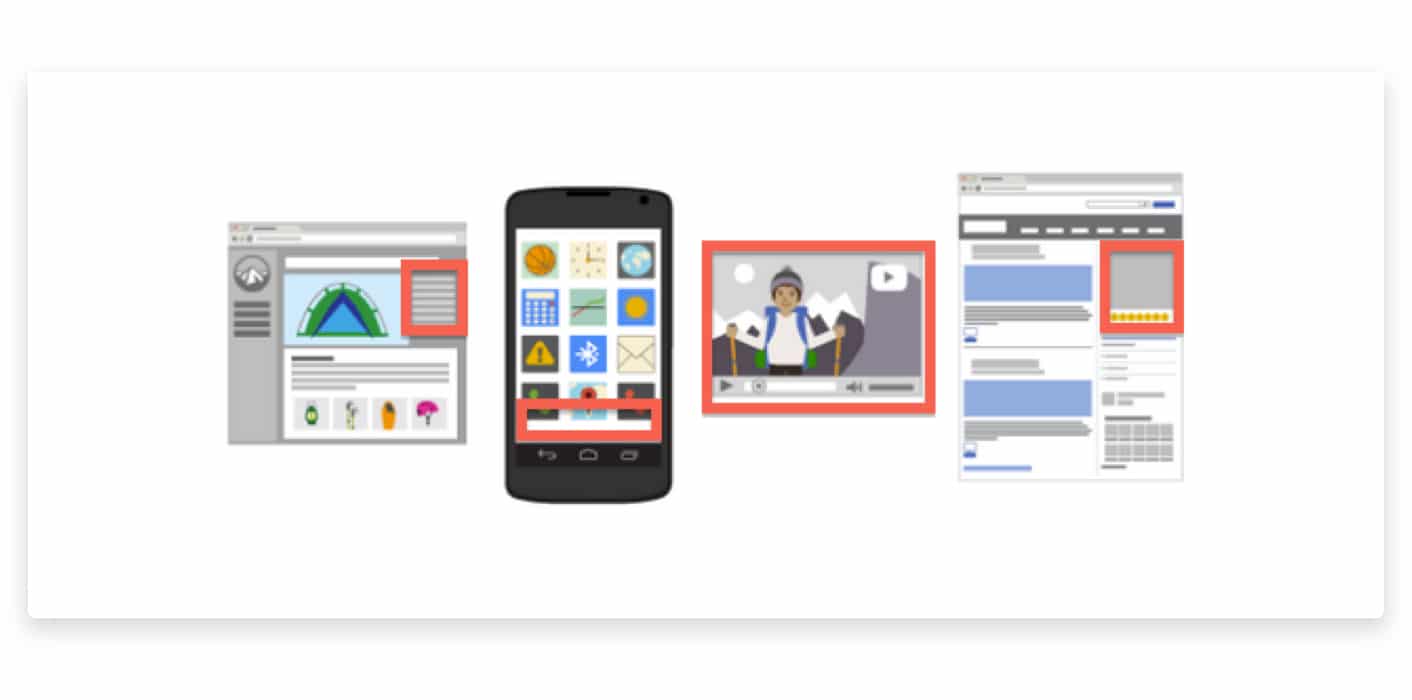 Source: Google
Source: Google
Average CPC for ads on the Display Network is under $1, and CTR averages out at about .60% across all industries. As far as ad formats go, Google has a lot to choose from:
- Text ad
- Image ad
- App promotion ad
- Shopping ad
- Dynamic Search ad
- Video ad
- Call-only ad
- Responsive ads for Display
- Outstream ad
Taken together, we can see that the Google Display Network is a powerful channel for almost any ad format. But in-stream video ads served through GDN present a special opportunity to stand out among mostly text- and image-based ads.
Side note: In case you’re wondering what the ROI for ads is like through the Display Network, WordStream reports that Google Advertisers drive about 20% of their conversions thanks to ads here.
Test all your options, but video is still your best bet
So, should you use video ads or image ads? We say you should test both. Every audience is different so one creative format may work better than the other.
With that being said, the data shows that people love video and want more of it.
So while you will probably test and find ads where images are the clear winner, high-quality video advertising is sure to play a key role in your paid advertising success.
Thankfully, you don’t need a huge budget or a product company to create your video marketing campaign. A tool like Promo.com makes it ridiculously easy to create as many video ads as you’ll need.
You don’t need to wait to start testing video ads and getting results.
[banner id=11706]

